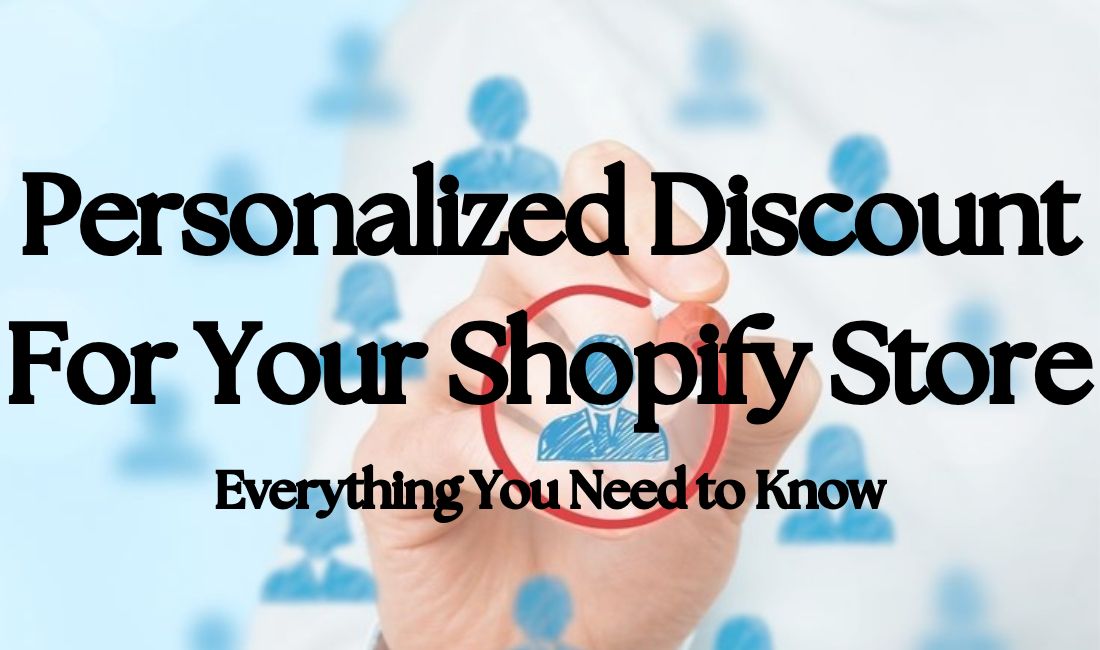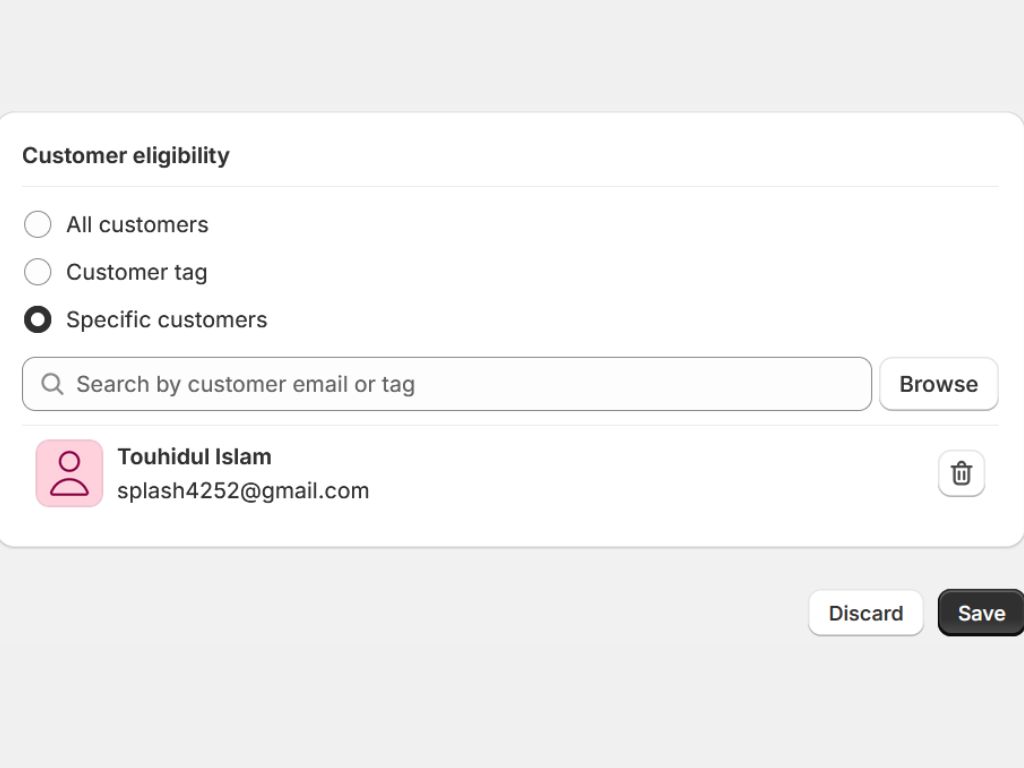
Consider this scenario: When you enter one of your favorite cosmetics boutiques, you are greeted by name. The salesman makes product recommendations based on your past purchases. This is an illustration of personalized marketing. Personalized discount is a part of it. It is growing in popularity in the current digital era.
You must determine what your customers genuinely care about to establish a connection with them. And there’s a proven way to do just that: personalized discounts. An AgilOne survey reveals that 66% of US shoppers felt special when they received emails offering discounts on products they had previously viewed.
However, there is a fine line between stalking the customer and collecting essential data. How do you draw the line? We assembled the ultimate guide for creating personalized discounts, along with the best approaches you must follow and the worst practices you must avoid.
A personalized discount is a unique deal designed with customers’ buying habits and preferences in mind. This approach offers a special nod to customers, saying, “We know what you love.”
So, how do personalized discounts work for a Shopify business?
You get a sure-shot sale whenever a customer applies a discount exclusive to them. You are building a relationship with that customer and making them feel heard. Giving each customer a deal no one else has can make them more loyal and likely to buy from you again.
Customized discounts are made to appeal to a particular client. They are tuned to their shopping preferences or based on their previous search history.
Tailored offers give your clients a sense of exclusivity and provide firms with several fantastic advantages.
Clients who receive personalized experiences feel appreciated and have a stronger bond with your company. Because of their customized discount, customers are more likely to receive what they desire, which also makes them happier and more grateful.
Many consumers believe that a brand’s experience is equally as significant as its goods. Customized savings might add a special touch to the encounter. Customers are more inclined to interact with your company when they receive offers that speak to their wants and requirements. This can result in more contact, comments, and, eventually, more sales for your business.
They are predicated on how consumers behave and engage with your brand. These discounts use behavioral information, including past purchases, browsing tendencies, and engagement levels. They are more likely to generate sales if they target particular activities. Customers will bond stronger with your brand and feel appreciated and understood.
These promotional offers are customized for particular customer groups based on demographic characteristics like age, geography, gender, occupation, or other socioeconomic considerations. These discounts assist companies in creating individualized experiences and successfully targeting specific customer segments. Additionally, they enhance the brand’s reputation.
One way to show appreciation for loyal customers is with a loyalty reward. It encourages repeat business, strengthens customer relationships, and increases client retention. These incentives may be freebies, points, discounts, or exclusive access to events or goods.
Customers who add items to their shopping cart but leave the business before completing the transaction can receive additional incentives called abandoned cart discounts. These discounts are a well-liked and effective strategy for recovering lost e-commerce revenue since they entice customers to return and finish their transactions.
Seasonal discounts are special offers or limited-edition goods connected to a specific yearly occasion. This could be a holiday, such as Memorial Day or Columbus Day, or a particular time of year, such as the start of the school year or valentine’s day discount.
Seasonal promotions draw attention to your business and increase brand awareness. They also boost product and money sales while increasing your visibility to customers.
A solid foundation for effective personalization lies in comprehensive data collection. Businesses must invest in powerful analytics tools that reveal insights into customer behavior, preferences, and purchase history.
Offer extra benefits like free shipping, bonus points, special access to products, and discounts. For instance, “Spend $50 and get free shipping” or giving devoted consumers first dibs on a deal.
Businesses can create tailored offers that resonate with each group’s unique preferences and shopping patterns by effectively segmenting customers into groups—like frequent buyers, occasional shoppers, or seasonal purchasers.
The true impact of a discount often hinges on its timing. Offering promotions during festive occasions or on customers’ birthdays can elevate their effectiveness and create a memorable experience.
Ensure that personalized discounts support your profitability and promote long-term loyalty. Steer clear of offers that may jeopardize your profit margins. Focus on incentives that drive repeat purchases rather than fleeting transactions, solidifying customer relationships over time.
Navigate to the ‘Campaigns’ section and select ‘Create New Campaign’. This will be your starting point for crafting a unique discount offer.
Decide how you want your offer to appear to customers. It provides options to display your discount as a banner or a widget, ensuring the promotion aligns seamlessly with your website’s design.
Determine the priority of your discount offer. This helps in streamlining multiple campaigns, ensuring the right offer is displayed to the right audience at the right time.
Choose the type of discount you wish to provide. It offers flexibility, allowing you to opt for a percentage discount, a fixed amount off, or even free shipping. Fill in the necessary details of your discount offer.
Decide the duration of your discount offer. Set a start and end date, ensuring your promotion aligns with any specific sales or seasonal events.
You can do it quickly with a discount app from Shopify store.

Before activating your campaign, take a moment to review all settings. Ensure everything aligns with your objectives and that the discount conditions are set correctly. Once everything looks good, launch your campaign and watch as it’s advanced personalization techniques enhance your customers’ shopping experience.
Creating personalized discount emails is an effective way to engage customers and drive sales.
Start with a compelling subject line. The subject line determines whether the email gets opened. Include the recipient’s name or reference their interests. Use action-oriented language (e.g., “Just for You: 20% Off Your Favorite Items!”).
Personalize the greeting. A personalized greeting makes the email feel tailored. Address the recipient by name. Add a friendly tone, such as “Hi [Name], we’ve got something special for you!”
Use customer data to tailor the offer. Relevant discounts are more likely to convert. Create discounts based on past purchases or browsing behavior. Highlight products that align with their preferences.
Design an eye-catching layout. A visually appealing email grabs attention and engages readers. Use high-quality images of products. Include clear headings and short, scannable text.
Include a clear call-to-action (CTA). A clear CTA directs customers to take action. Use buttons with action words like “Shop Now” or “Claim Your Discount.” Position the CTA prominently and repeat it at the end.
Add a sense of urgency. Urgency encourages quick decision-making. Use phrases like “Limited Time Offer” or “Only 24 Hours Left!” Consider adding a countdown timer.
Highlight the benefits. Customers are motivated by value. Clearly state the discount (e.g., “Save 30% on Your Next Order”). Emphasize perks like free shipping or bonus points.
Optimize for mobile. Most emails are opened on mobile devices. Use a responsive design. Keep the email concise and ensure all elements are easily clickable.
Test and optimize. Testing helps improve email performance. A/B test subject lines, visuals, and CTAs. Monitor open rates, click-through rates, and conversions.
Track the number of uses of the coupons and discount codes you send. Keep tabs on how much each person pays with the coupon or discount code. Also, try to figure out whether they use the coupons or discount codes after the sale period has passed. This will give you an accurate estimation of whether your discounts are working as you had intended or whether you have to change them.
It is also paramount to track the right indicators to quantify the effectiveness of your bespoke coupon campaigns.
The redemption rate is the percentage of coupons used compared to the distributed total. A higher redemption rate often indicates better targeting and relevance.
Monitor how personalized coupons affect the average order value (AOV). Ideally, you want to see an increase in AOV even with discounts applied.
Track how coupon campaigns impact customer lifetime value (CLV) over time. Effective personalization leads to increased loyalty and higher CLV.
Determine the return on investment (ROI) of coupon campaigns compared to the implementation expenses and available discounts. Calculate the extra sales the coupon promotion brought.
For campaigns targeting new customers, track how personalized coupons affect your customer acquisition cost (CAC).
Create a dashboard that visualizes these metrics over time. You can quickly identify trends and areas for improvement.
Avoiding poor practices in personalized discount strategies is critical to maintaining customer trust and maximizing the effectiveness of campaigns. Here are some of the worst practices to avoid:
Over-Personalization can come off as intrusive. Imagine receiving this message “We noticed you viewed [product] 5 times today!”. Scary, right? Customers may feel their privacy is violated and lose trust in your brand.
Sending irrelevant offers for products or services unrelated to the customer’s interests might cost you your brand image. For example, offering baby products to someone without children. It reduces engagement and signals a lack of understanding about the customer.
Ignoring purchase history can lead to offering discounts on products a customer has already purchased or ignoring known preferences. It wastes resources and annoys customers.
Unclear or misleading terms make discounts hard to redeem. Your customer won’t be able to trust you properly.
You can’t offer out-of-season products or discounts that don’t align with customer needs. For example, don’t offer a discount on winter coats in summer.
No A/B testing means failing to test offers for effectiveness and customer appeal. You will miss opportunities to optimize campaigns and improve ROI.
Personalized discounts are great incentives for customers. They will visit and shop more to get discounts again. It’s a great way to boost and increase your sales. Word of mouth can attract new customers. All you have to do is plan and execute properly. Try for yourself. Come back to this article again if you need any guidance.
Compliance with data protection laws like GDPR and CCPA is crucial. Be transparent with customers about how their data is used and provide options for them to control their data.
Analyze purchase history, frequency, preferences, and even demographics to create meaningful customer segments. Use these insights to tailor offers that resonate with each group.
This depends on your customer base and industry. Monitor customer engagement and purchase patterns to determine the optimal frequency. Avoid overwhelming customers with too many offers.
Over-segmenting customers, ignoring privacy concerns, and being too aggressive with offers are common pitfalls. It’s also important to ensure that the discounts are financially sustainable for your business.